
Entrance to the South Temple. (710k)
I visited the Tarxien Temples, Ħaġar Qim, the Mnajdra Temple, the Skorba Temple, and the Cart Ruts at Misraħ Għar il-Kbir.
The Megalithic Temples of Malta are a UNESCO World Heritage Site. They include Ġgantija, Ħaġar Qim, Mnajdra, Skorba, Ta' Ħaġrat and Tarxien. The Megalithic Temples of Malta are among the most ancient religious sites on Earth, described by the World Heritage Sites committee as "unique architectural masterpieces."
The Stone Age sites on Malta are splendid examples of the many sites of Ancient Civilizations that I visited during my travels.
All pictures are © Dr. Günther Eichhorn, unless otherwise noted.
The Tarxien Temples are an archaeological complex in Tarxien, Malta. They date to between 3600 BCE and 2500 BCE.
The Easternmost Temple is the oldest structure (3600-3200 BCE). Only the lower parts of the walls survive.
The other three structures, the South Temple, East Temple, and Central Temple date to 3150-2500 BCE. The South Temple is rich in prehistoric art. The Central Temple is the last structure to be built. It has a six-chambered plan and contains evidence of roofing.










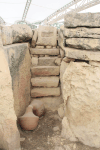





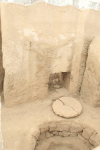



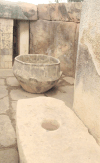

From the Wikipedia entry for Ħaġar Qim
Ħaġar Qim ("Standing/Worshiping Stones") is a megalithic complex, dating from the Ġgantija phase (3600-2500 BCE). Today it is called a temple, but we actually know little about what went on in these buildings.
The Ħaġar Qim complex consists of a main structure and three additional megalithic structures beside it. The main structure was built between 3600 and 3200 BCE; however, the northern ruins are considerably older. The outside entrance serves as an interior passage and connects six large chambers. The right apse is constructed as an arch to prevent the upright slabs falling inward. The outside wall, built of huge upright blocks, projects inwards, thus creating an extremely solid building. This entrance passage and first court follow the Maltese megalithic pattern but as building progressed, this design was considerably modified. The northwesterly apse was replaced by four independent enclosures.
Ħaġar Qim shares its basic architectural design with the Mnajdra, Tarxien and Ġgantija complexes. The basic shape includes forecourt and facade, elongated oval chambers, semi-circular recesses and a central passage connecting the chambers. This configuration is commonly termed "trefoil". It is also suggested that the shape of the structure in some way mimics the sacred sculptures found within them.









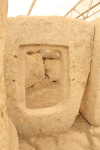







From the Wikipedia entry for Mnajdra
Mnajdra is a megalithic temple complex on the southern coast of Malta. Mnajdra is approximately 500 m (1,640 ft) from the Ħaġar Qim megalithic complex. Mnajdra was built around the fourth millennium BCE. Building materials were the harder coralline limestone, used mainly for the outer walls, and the softer globigerina limestone, used mainly in the interior.
The cloverleaf plan of Mnajdra consists of three temples, conjoined, but not connected: the upper, middle, and lower.
The upper temple is the oldest structure in the Mnajdra complex and dates to the Ġgantija phase (3600-3200 BCE). It is a three-apsed building, the central apse opening blocked by a low screen wall. The pillar-stones were decorated with pit marks drilled in horizontal rows on the inner surface.
The middle temple was built (or possibly rebuilt) in the late Tarxien phase (3150 – 2500 BCE), the main central doorway of which is formed by a hole cut into a large piece of limestone set upright, a type of construction typical of other megalithic doorways in Malta. This temple appears originally to have had a vaulted ceiling, but only the base of the ceiling now remain on top of the walls and, in fact, is the most recent structure. It is formed of slabs topped by horizontal courses.
The lowest temple, built in the early Tarxien phase, is the most impressive and possibly the best example of Maltese megalithic architecture. It has a large forecourt containing stone benches, an entrance passage covered by horizontal slabs, one of which has survived, and the remains of a possibly domed roof. The temple is decorated with spiral carvings and indentations, and pierced by windows, some into smaller rooms and one onto an arrangement of stones.








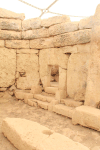









From the Wikipedia entry for Skorba Temples
The Skorba temples are megalithic remains on the northern edge of Żebbiegħ, in Malta, which have provided detailed and informative insight into the earliest periods of Malta's neolithic culture. The temple dates from 3600 BCE, the earliest remains date back to about 4850 BCE.
The remains on the site are a series of megalithic uprights (one of them 3.4 m (11.2 ft) high), the lowest course of the temples' foundations, paving slabs with libation holes in the entrance passage, and the torba (a cement-like material) floor of a three-apse temple. This three-apse shape is typical of the Ġgantija phase. Unfortunately, the greater part of the first two apses and the whole of the facade have been razed to ground level.
The north wall is in a better state of preservation. Originally, the entrance of the temple opened on a court, but in later additions during the Tarxien phase, the temple's doorway was closed off, with altars set in the corners formed by the closure. East of this temple, a second monument was added in the Tarxien phase, with four apses and a central niche.
For a period of roughly twelve centuries before the temples were built, a village already stood on the site. Its oldest extant structure is the eleven meter long straight wall to the west of the temples' first entrance. Deposits at its base contained material from the first known human occupation of the island, the Għar Dalam phase, including charcoal, which carbon analysis dated to 4850 BCE.






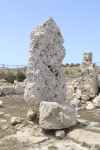

Misraħ Għar il-Kbir (informally known as Clapham Junction) is a prehistoric site in Siġġiewi, Malta, near the Dingli Cliffs. It is best known for its "cart ruts" - a complex network of tracks gouged in the rock. The age and purpose of the tracks are still a mystery of Maltese history. In general, most archaeologists presume that the site developed about 2000 BCE after new settlers came over from Sicily to start the Bronze Age in Malta. See the Wikipedia entry for Misraħ Għar il-Kbir for more details.
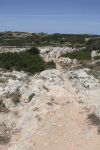


This page contains 68 pictures
Page last updated on Tue Sep 24 18:19:03 2019 (Mountain Standard Time)
Malta - Stone Age Monuments on gei.guenther-eichhorn.com